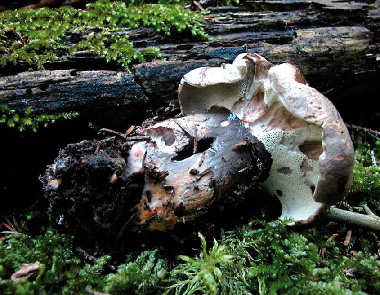Black falsebolete: Red Data Book of Armenia

Category. EN – Endangered.
Brief description. Fruit bodies are annual, with central or eccentric cap. Cap is from 5 to 15 cm across, ash–grey, then grey, globose, flat or light planoconvex, with sharp thick margin. The surface is covered with thin cuticle with age becoming cracked. Flesh is white at first, pink when cut, with violet colouring, then grey or ash–grey. Hymenophore is porous, the pores are one–layered, short, white, grey, ash–grey up to 4 mm long and consist of rather small pores. Stipe is 2–4 x 1–3 cm long, having the colour of the cap surface, central or eccentric, cylindrical, hard, smooth, sometimes with bulb at the base. The flesh is greenish. Spore print is white or greyish. Spores are 4,5–7 x 3,5–5 µm, light brown, globose or ellipsoid, warty.
Distribution. Generally in Europe, North America, Southern Caucasus (Armenia). It is wide spread in Boreal zone. In Armenia the unique fruit bodies of this fungi are found in Ijevan floristic region – in "Dilijan" National Park, in surroundings of "Akhnabat yew" forest.
Ecological, biological and phytocenological peculiarities. It is met on the soil, in mixed forests on the altitude of 1600 m above sea level in September. Mycorrhizal fungi, with oak, hornbeam, conifer trees. The fruit bodies are edible.
Main factors of endangering. The main factors of endangering are human economic activity, among which is uncontrolled forest cutting which leads to the degression of places necessary for the growth of mushrooms in Armenia.
Nature conservation measures. In Armenia it is conserved in corresponding ecosystems of "Akhnabat yew" Reserve.
Suggestions
 The Ministry of Environment sent a letter international partners to draw their attention to the real danger of environmental disasters as a result of Azerbaijan's large-scale aggression towards the territory of Armenia
The Ministry of Environment sent a letter international partners to draw their attention to the real danger of environmental disasters as a result of Azerbaijan's large-scale aggression towards the territory of Armenia
 Vicia pisiformis: Red Data Book of Armenia
Vicia pisiformis: Red Data Book of Armenia
 Vavilovia formosa: Red Data Book of Armenia
Vavilovia formosa: Red Data Book of Armenia
 Trigonella capitata: Red Data Book of Armenia
Trigonella capitata: Red Data Book of Armenia
 Trigonella astroides: Red Data Book of Armenia
Trigonella astroides: Red Data Book of Armenia












